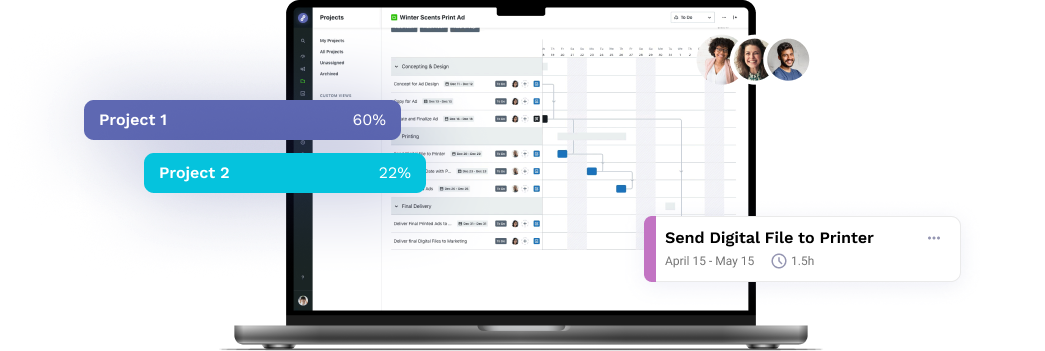
Our professional relationships, just like our personal ones, deserve our attention and focus. We all have favorite stakeholders who are an absolute pleasure to work with and make project collaboration a breeze. And then, we have some stakeholders that can be particularly challenging and difficult to work with at times. Thankfully, we have gathered a few stakeholder strategies you can use to improve those relationships. And even, dare we say, help them blossom!
5 Stakeholder Strategies to Help You Deal with Challenging Stakeholders
1. Have an Open and Honest Conversation About Your Mutual Challenges
It takes two to tango after all, right? We are 50% responsible for everything that transpires between us and other people. So, take a few moments to examine your own behavior and admit the part you play in the situation. Then, research various feedback models – we strongly suggest you read Crucial Conversations – and go with the one that feels right. Now, you may want to approach the stakeholder and ask if you two can talk. Once you are in a quiet room, now’s the time to share your thoughts – strategically. You can use the following example as reference:
- Provide context for the meeting by mentioning how the current situation is not ideal and that you wish to find better ways to communicate and collaborate with them. Acknowledge that this may come as a shock to them and let your intentions sink in with your stakeholder for a moment.
- Your next step should be to mention the behaviors you wish to discuss with your stakeholder in a clear and specific manner. Choose your words carefully and be respectful of the person opposite you, no matter how hard it may be. Avoid passing judgement to prevent defensiveness on their part. If they get defensive, they will no longer be open to your constructive criticism.
- Finally, describe and highlight the impact their behavior has been having on you, the rest of the team, and the organization (if applicable). Allow your stakeholder to process your constructive feedback and come back to you with their thoughts and comments. We strongly recommend that you encourage your stakeholder to share in a comparable way.
2. Try Walking a Mile in Their Shoes
You can do so by familiarizing yourself with your stakeholder’s background, life experiences, and role. This exercise in empathy is meant to help you better understand their behavior. It is not meant to excuse their behavior, as you deserve to be treated with respect no matter what. You can find some common ground and build a positive work relationship from there.
How you go about this is entirely up to your personal preferences and communication style. One thing to consider that works well is to use this strategy to complement a wider conversation. For best results, use it in conjunction with strategy #1.
3. Identify and Fix Process Bottlenecks
All the stakeholder strategies in the world cannot mitigate for the internal conflict created by ill-defined processes and lack of clear communication. You know what would really help you and your stakeholders work better together? Adapting a creative operations mindset to eliminate process bottlenecks and reduce internal conflict.
Read this blog post on helping creative teams thrive with creative operations to learn more.
Try Lytho’s creative operations software to identify and fix process bottlenecks and improve stakeholder communication today! We at Lytho help you streamline your entire workflow and harmonize all brand collateral under a single, uniform platform. Feel free to reach out to us by scheduling a demo and learning how our creative solutions can boost the effectiveness of your creative projects. We look forward to speaking with you!
4. Do NOT Take Their Behavior Personally
In fact, research has shown that creative individuals tend to be more stubborn, self-absorbed, and narcissistic than the average person. And that is to everyone and on a good day! Hey, there must be catalyst behind the clarity, insistence, and perseverance needed to execute a strong creative vision, isn’t there?
So, where does this leave you? In reality, we all take things personally – we are hard-wired to do so. If someone is hard to work with and you have already tried all the above, it may be time to try a different approach. Reach deep within yourself and recommit to your own values. Then, remind yourself that you will not be swayed by what your stakeholder says and does, and that you know who you truly are. This exercise will help you keep a cool head when interacting with them. And speaking of interactions, you may wish to keep them to a minimum.
5. DO Ask Your Manager for Assistance
If all previous stakeholder strategies have proven ineffective, then go to your manager immediately. There is power in knowing your limits and when it is time to enlist someone else’s help. Start by finding a convenient time and place to meet and share your agenda with your manager in advance. This will give them time to prepare for the conversation and guide you in the right direction.
Remember Stakeholder Strategies Help to an Extent
And that you should report any behavior you deem inappropriate to HR and your manager regardless. There is a firm line between different communication styles and downright rude behavior. A professional environment is one where people feel safe and respected. You should report any changes to that as soon as you notice something that is off. If you want, you can also review your organization’s handbook to be fully informed about the help that is available.
References:
Collaborating with a difficult co-worker: Do’s and don’ts
12 Ways to Deal With a Difficult Co-Worker
4 Tactics that Backfire When Dealing with a Difficult Colleague
Relationship Fairness: What a 50/50 Balance Means
Five strategies for effective stakeholder management
Crucial Conversations: Tools for Talking When Stakes Are High, Second Edition
Do you want to give yourself and your creative team more room for creative stimulation by automating the boring stuff? Lytho helps you streamline your entire workflow and harmonize all brand collateral under a single, uniform platform. Feel free to reach out to us by scheduling a demo and learning how our creative solutions can boost the effectiveness of your creative projects. We look forward to speaking with you!

Ready to simplify your creative operations and start having a little fun at work again? Schedule time to talk with us.
Let us show you how Lytho’s Creative Operations Platform helps in-house creative and marketing teams do better work, ease the stakeholder experience, and stay on brand.
Schedule a Demo